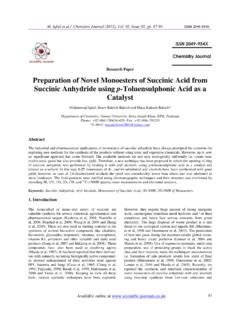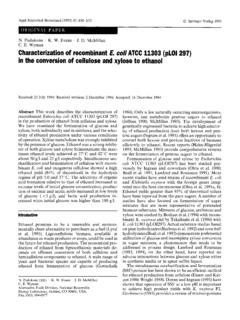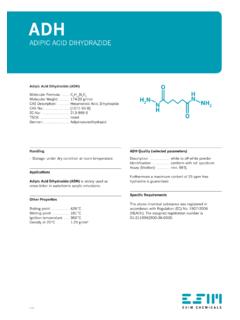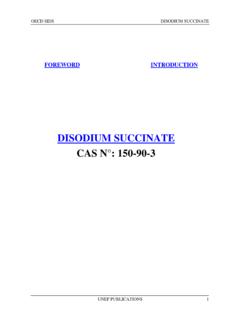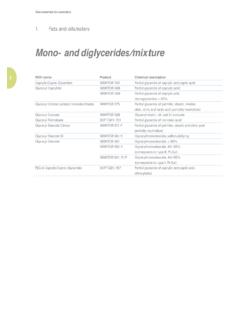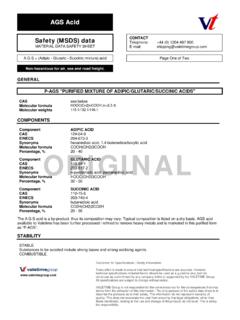Transcription of Bio-Lubricants
1 CREATING VALUE | BrochureCONTENTSAZELAIC ACIDSO verview 05 Physical Constants of Dicarboxylic Acids 06 Manufacture of Azelaic Acid & Polymer Intermediates 07 Saponification & Metallic Soap Polymers 09 Lubric ants & Greases 11 Finishing & Packaging 12 PELARGONIC ACIDSO verview 14 Applications 15 Metallic Soaps 16 Activated Oxygen Bleaches 17 Finishing & Packaging 18 DIMER ACIDSO verview 20 Product Information 21 ESTERSO verview 23 Product Information 24 OILFIELDO verview & Product Information 26 Release 08/ 2013 Subject to alteration & errors and omissions : The information provided herein is for the sole purpose of presenting Emery Oleochemicals, its products and services. It is given without any express or implied representation, guarantee, or warranty of completeness, correctness or any other kind of products in the text marked with an are trademarks of Emery Oleochemicals. The information on product specifications provided herein is only binding to the extent confirmed by Emery Oleochemicals in a written Sales Agreement.
2 EMERY OLEOCHEMICALS EXPRESSLY DISCLAIMS ANY RESPONSIBILITY FOR THE SUITABILITY OF THE PRODUCTS FOR ANY SPECIFIC OR PARTICULAR PURPOSES INTENDED BY THE USER. Suggestions for the use and application of the products and guide formulations are given for information purposes only and without commitment. Such suggestions do not release Emery Oleochemicals customers from testing the products as to their suitability for the customer s intended processes and purposes. Emery Oleochemicals does not assume any liability or risk involved in the use of its products as the conditions of use are beyond its control. The user of the products is solely responsible for compliance with all laws and regulations applying to the use of the products, including intellectual property rights of third INNOVAT I O N in natural-based lubricants for a sustainable tomorrowLeader in Natural-Based ChemistriesEmery Oleochemicals is a leading global provider of high performance and natural-based chemicals with a Bio-lubricant platform that enables our customers to formulate innovative and sustainable lubricant VALUE NaturallyWe are committed to C REATING VALUE for you with our combined strengths in global manufacturing, research and development, distribution, marketing, and technical know-how.
3 Uniquely packaged, our competitive advantage enables us to offer you innovative and competitive solutions designed to meet your Lubricant SolutionsEmery Oleochemicals products are used to improve processing efficiencies, provide outstanding technical performance, and enhance environmental safety in lubricant applications including oilfield chemicals, hydraulic fluids, base oils, greases, and lube base stocks. We offer environmentally sustainable products including azelaic acid, pelargonic acid, dimer acid, isostearic acid, esters, and other types of natural-based fatty acids and Global PartnerEmery Oleochemicals is committed to being your preferred partner in innovative and high performance natural-based ingredients for lubricant applications designed for a sustainable AZELAIC ACIDS OVERVIEWA zelaic acid is a 9-carbon, straight chain, saturated, dibasic acid produced commercially by the ozone oxidation of oleic acid. Its chemical name is 1,9-nonanedioic acid, or heptane-1, 7-carboxylic acid.
4 (FIGURE 1) Azelaic acid is a crystalline, opaque-white solid, soluble in hot water, alcohols, diethyl ether, and other polar solvents, as shown in Table 1. The two carboxyl groups of azelaic acid limit its solubility in nonpolar solvents such as naphtha or carbon monomeric derivatives of azelaic acid generally have lower melting points and greater solubilities than the corresponding derivatives of even-carbon dicarboxylic acids. The influence of the odd-carbon structure on melting points and physical properties of aliphatic dibasic acids is shown in Table 2. Table 3 shows the influence of the odd-carbon structure on the melting points of some simple (monomeric) Table 3 indicates, the monomeric azelaic derivative in each instance has a lower melting point than either of the corresponding adipic or sebacic derivatives. Azelaic acid is the preferred aliphatic dibasic acid for the preparation and modification of high molecular weight polymers in many industries.
5 Unlike petroleum based adipic acid, azelaic acid is derived from replenishable oleochemical raw materials. Furthermore, its odd-carbon structure imparts unique properties to polymers and derivatives that can be utilized 1 Azelaic AcidsSOLUBILITY OF EMEROX 1144 AT 27 CSOLVENTWT. %WAT E R0. U L E N 167 PHYSICAL CONSTANTS OF DICARBOXYLIC ACIDS ACIDFORMULASOLUBILITY IN H20 @20 C, CIONIZATION CONSTANT, K1 succinic (CH2)2(COOH) (CH2)3(COOH) (CH2)4(COOH) (CH2)5(COOH) (CH2)6(COOH) (CH2)7(COOH) (CH2)8(COOH) 2 TABLE 3 MANUFACTURE OF AZELAIC ACID & POLYMER INTERMEDIATESThe present line of EMEROX Azelaic Acids is the result of over 60 years of research by Emery Oleochemicals, pioneer in the commercial development of azelaic acid. Early in this period, an economical process to split oleic acid into two completely new commercial products, azelaic and pelargonic acids, was developed. The initial commercial plant was based on the oxidation of oleic acid by chromic acid.
6 Further pioneering led to Emery Oleochemicals unique ozonolysis-oxidation first commercial ozone plant for the continuous production of azelaic acid was completed in 1953. Other plants have since been erected, adding substantially to capacity. Emery Oleochemicals is the world s largest commercial producer of azelaic acid, as well as the world s largest industrial producer and consumer of process uses the powerful reactivity of ozone to cleave oleic acid into azelaic and pelargonic acids. After extensive separation and purification operations, the azelaic acids are flaked and packaged for shipment in 25 kilogram multiwall paper bags and 700 kilogram Supersacks. A comprehensive Statistical Quality Control (SQC) program supplements automatic equipment and controls throughout the plant to ensure that each shipment meets Azelaic Acids EMEROX Azelaic Acids are available to meet the product quality and cost/performance relationships required for specific applications.
7 EMEROX Azelaic Acids are marketed in both technical and polymer grades. Specifications and typical characteristics of Emery Oleochemicals azelaic acids are listed in Table 4. PHYSICAL CONSTANTS OF DICARBOXYLIC ACIDS ACIDACID ANILIDE, C AMIDE, C ESTER, CP-NITROBENZYLESTER, CP-BROMOPHENACYLMALONIC (C3)22417085- succinic (C4)22624288211 GLUTARIC (C5)22417469137 ADIPIC (C6)235220106154 PIMELIC (C7)155--137 SUBERIC (C8)18721685144 AZELAIC (C9)18517544131 SEBACIC (C10)19821072147 SPECIFICATIONS & TYPICAL CHARACTERISTICS OFEMEROX 1110, EMEROX 1112 & EMEROX 1144 AZELAIC ACIDS PRODUCTEMEROX 1110 AZELAIC ACIDEMEROX 1112 AZELAIC ACIDEMEROX 1144 AZELAIC ACIDSPECIFICATIONSACID VALUE, MgKOH/g576 - 591574 - 591587 - 594 COLOR, % TRANS 440/550 nm ACID, %, ACID, %, CHARACTERISTICS EQUIVALENT WEIGHT, g/eq969695 MELTING POINT, C96 - 10399 - 100100 - 102 COMPOSITION (GLC wt %) DIBASIC ACID <C9734 DIBASIC ACID C9798589 DIBASIC ACID >C912127 MONOBASIC 4 PHYSICAL CONSTANTS OF DICARBOXYLIC ACIDS89 Saponification & Metallic Soap Polymers FIGURE 2 Azelaic acid saponifies readily with alkali metals to form alkali metal salts which are highly water soluble, but which exhibit no detergency.
8 Salts of calcium, magnesium, aluminum, and other metals are insoluble in water and in common organic solvents. Basic oxides of multivalent metals such as ZnO will react with azelaic acid to form FIGURE 3 Monohydric alcohols react with azelaic acid to form relatively high boiling diesters. These diesters are efficient plasticizers and impart excellent low temperature flexibility to vinyls, cellulosics, and neoprene, nitrile, and butadiene-styrene rubbers. They are also used as base fluids for synthetic lubricants and greases where they exhibit excellent viscosity/temperature relationships and provide excellent lubrication over wide temperature and other polyols react with azelaic acid to yield polyesters. If the resulting polyester contains an excess of reactive groups, it can react further with cross-linking agents or extenders. Polyurethane resins result from the chain extension of hydroxyl terminated azelaic polyesters with diisocyanates of isocyanate FIGURE 4 Linear polyamides, formed by the reaction of azelaic acid with diamines, are an increasingly important group of polymers.
9 These polyamides usually require polymer grade EMEROX 1144 Azelaic Acid which can act either as the principal dibasic acid component ( , 6,9 nylon) or as a dibasic acid are also produced by reacting azelanitrile with formaldehyde. The resulting poly (methylene azelamide) is reported to have properties similar to those of commercial poly (hexamethylene adipamide).Under suitable conditions, ammonia and primary or secondary amines react with azelaic and its derivatives to form amides. The simplest is azelamide which melts around 175 FIGURE 5 Reduction by sodium, hydrogenation over cupric chromite, or high pressure reduction of the diester yields the corresponding glycol (1,9-nonanediol).This alcohol has a melting point of approximately 45 and is insoluble in both water and petroleum ether. The hydroxyl acid (9-hydroxynonanoic acid) can also be formed and exhibits solubilities similar to that of 1, Chloride FIGURE 6 Reaction with phosphorus pentachloride or with thionyl chloride yields the acid chloride of azelaic acid.
10 This acid chloride may then be used in the preparation of other 1110A technical grade of azelaic acid which typically contains 79% azelaic acid, 19% other dibasic acids and 2% monobasic acids. EMEROX 1110 has found extensive application in the preparation of low-temperature and polymeric type vinyl plasticizers, ester-based synthetic lubricants, and lithium complex 1112A grade of azelaic acid which typically contains 85% azelaic acid, 15% other dibasic acids and monobasic acids. EMEROX 1112 has found extensive application in the preparation of low-temperature and polymeric type vinyl plasticizers, ester-based synthetic lubricants, and lithium complex 1144 This is the purest grade of azelaic acid commercially available, and was developed specifically for the preparation and modification of high molecular weight polymers. It contains approximately 89% azelaic acid, 11% other dibasic acids, and a maximum monobasic acid content of The introduction of a linear odd-carbon structure of EMEROX 1144 usually improves the polymer low-temperature impact strength, without sacrificing high temperature performance.




